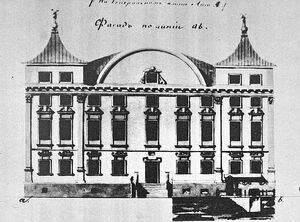Sapieha Palace, Vilnius
Sapieha Palace (Lithuanian: Sapiegų rūmai, Polish: Pałac Sapiehów w Wilnie) is a High Baroque palace in Sapiegos str., Antakalnis district of Vilnius, Lithuania. It is the only surviving of several palaces formerly belonging to the Sapieha family in the city. The palace is surrounded by the remains of the 17th-century formal park, with parterres, ponds, and avenues. The impressive Baroque gate secures the entrance to the park from Antakalnis street and the other gate is on the opposite side of the park, near the palace. Both of them were restored in 2012.
History

The palace, ordered by Great Hetman of Lithuania Jan Kazimierz Sapieha the Younger was built in Baroque style in 1691–1697 in place of the former wooden mansion of Lew Sapieha (who died here in 1633). The palace was designed by Giovanni Pietro Perti and decorated with frescos by Michelangelo Palloni. The piano nobile has initially displayed Dutch tiles and mosaics representing blazons, churches, castles, and palaces owned or built by the Sapiehas. Originally, the palace had multi-floor arcades on its sides,[1] which were later built up to gain more space inside the building. Jan Kazimierz Sapieha the Younger by building the luxurious Sapieha Palace ensemble wished to surpass the John III Sobieski projects and to show his power and ability to be a Grand Duke of Lithuania and King of Poland.[2]
19th century
In 1809 the palace was acquired by the Russian government and restructured (according to Józef Poussier's design) into a military hospital in 1843. Much of the rich interior was destroyed throughout the 19th century.
20th century
The exterior of the palace was restored only in 1927-1928 and the building housed University's ophthalmology institute until World War II. Since the war, it has been used as a military hospital again and fell into disrepair.
21st century
In the early years of the century the complex housed the Sapieha Hospital (Lithuanian: Sapiegos ligoninė). Since 2012, the palace has been undergoing restoration, in an attempt to bring it as close as possible to its original Baroque appearance.